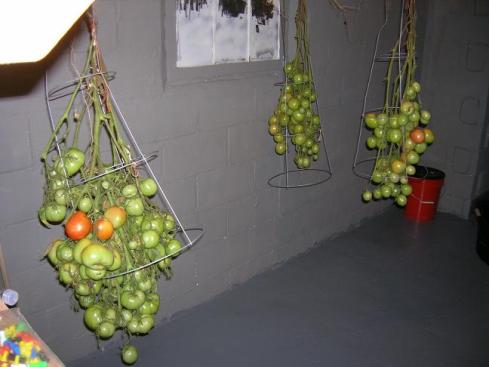The old microfarm; my love and my sorrow.
The one problem with gardening for me is that I start the year all gung-ho about growing vegetables, but yet by the time September rolls around I have a hard time dredging up the enthusiasm to finish what I have started; especially when I am not confident about what I will be getting.
It has been an odd year here in Duluth. June was almost as cold as April, and then July and August were way hotter than normal. All of the extremes are tough on plants and I just didn’t know what to expect.
We got some serious frosts recently when the weather went from 80s during the day (pretty warm for up here) one week to a series of nightly freezes and days topping out in the 40s and low 50s the next week. Although I covered everything the best I could, after three consecutive freezes it was time to bring in the tender plants. (I know I should have harvested them before the frost, but time has been at a premium lately).
First the bad: The potato tower is a glorious failure. I forgot to report the results of last year’s harvest, but back then the tower only produced potatoes in the bottom 10 inches of soil (i.e. the same output you would expect hilling them traditionally). This year, using my homemade compost and filling in the dirt religiously, I have less potatoes by weight than the seed I planted in April (I think there was too much nitrogen in the compost). <sigh> I am done trying to grow potatoes in the tower; I will grow them in the ground like people have been doing for thousands of years. However, I think that the tower will make a decent tomato planter if I only fill it part way up and take out some of the boards. Besides, trying to keep up with compost production and the potatoes’ growth was more trouble that it was worth.
The good news it that I should have beans coming out of my ears if they dry properly. I grew pinto beans this year, and when the frosts hit about half of the pods were still green. In the past green pods have still matured and dried properly for me, albeit with smaller beans; we will see. By volume, however, I have double the pods of last years harvest. Last year I planted the plants 8″ apart, but that reduced the yield dramatically for all but the outermost plants. This year I put in two plants every 12″ in rows 18″ apart and used drip irrigation to keep the watering even. So even though I planted 40% less seed, I got double the yield. Pinto beans were probably not the best choice; next year I think I will grow Hidatsa shield figure beans again as they are a shorter season variety and still produce well.
This year I also grew tomatoes for the first time. I had a lot of fruit on the vines, but when the frost/freeze warnings were posted they were all still green; I assumed that it was a lost cause. I was lamenting that fact to a customer of mine who had an interesting solution. For years she has been growing tomato plants by the hundred and she told me to pull the vines up by the roots, trim off the excess foliage, and hang them in my basement; she gets tomatoes until December that way.
Here you can see the tomatoes in my basement, and some of them are stating to ripen. If this works as well as she promises I will be doing it every year. The tomatoes are also supposed to mature more slowly, so rather than having them all ripen at once they might last over a longer period. At least there is less of a chance of frost in my basement.
Most of the rest of my plants are hardy and they are still out there in the garden: onions, carrots, parsnips, cabbage, and collar greens. I also grew broccoli, but with all the weather extremes I got just one little florette out of six plants. Next year I plan to rig shade cloth over the broccoli, cabbage, and collards to help keep them cool; we will see if that helps.
At least I have something to show for my hard work, but I am glad I still have my day job.


Leave a comment
Comments feed for this article